To host a donation drive step by step, start by defining your goals and target audience, then choose what types of donations you’ll accept. Select a suitable, accessible location and plan your timeline. Gather supplies, prepare collection containers, and recruit volunteers to help. Set up the collection site, manage donations efficiently, and thank supporters throughout the process. If you keep exploring, you’ll find detailed tips to guarantee your drive’s success.
Key Takeaways
- Define clear goals, target beneficiaries, and donation objectives to guide planning and outreach efforts.
- Secure suitable collection locations, gather supplies, and ensure necessary permits and safety measures are in place.
- Promote the drive through social media, community networks, and local media to maximize awareness and participation.
- Manage donations efficiently by setting up organized collection sites, sorting items, and tracking contributions.
- Engage volunteers, acknowledge supporters, and follow up with recipients to ensure transparency and measure impact.
Define Your Goals and Target Audience
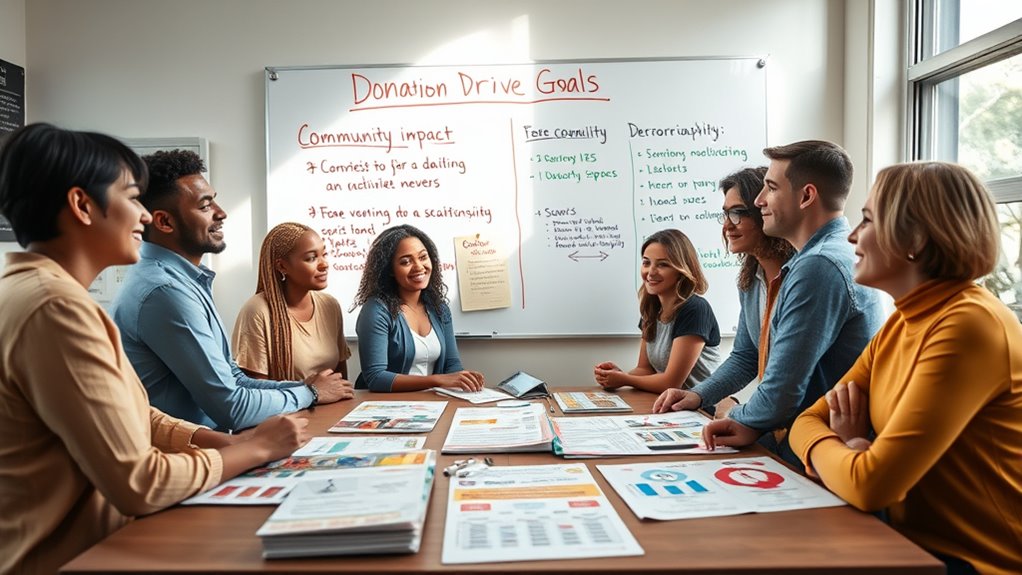
Before launching your donation drive, it’s essential to clearly define your goals and identify your target audience. Knowing what you want to achieve helps you develop effective fundraising strategies and tailor your messaging. Consider whether you’re raising funds for a specific project, general operations, or emergency relief, as this shapes your donation policies and outreach. Understanding your target audience allows you to select the right channels and appeal to their motivations. Are you targeting individuals, corporations, or community groups? Clarifying these aspects upfront ensures your efforts are focused and impactful. Well-defined goals and audience insights set a strong foundation for your donation drive, increasing the likelihood of reaching your objectives and creating meaningful engagement. Additionally, understanding the data privacy challenges and how they relate to transparent data handling can help you communicate the impact and importance of your cause more effectively to engaged supporters interested in innovation and sustainability.
Choose the Type of Donations and Collection Items
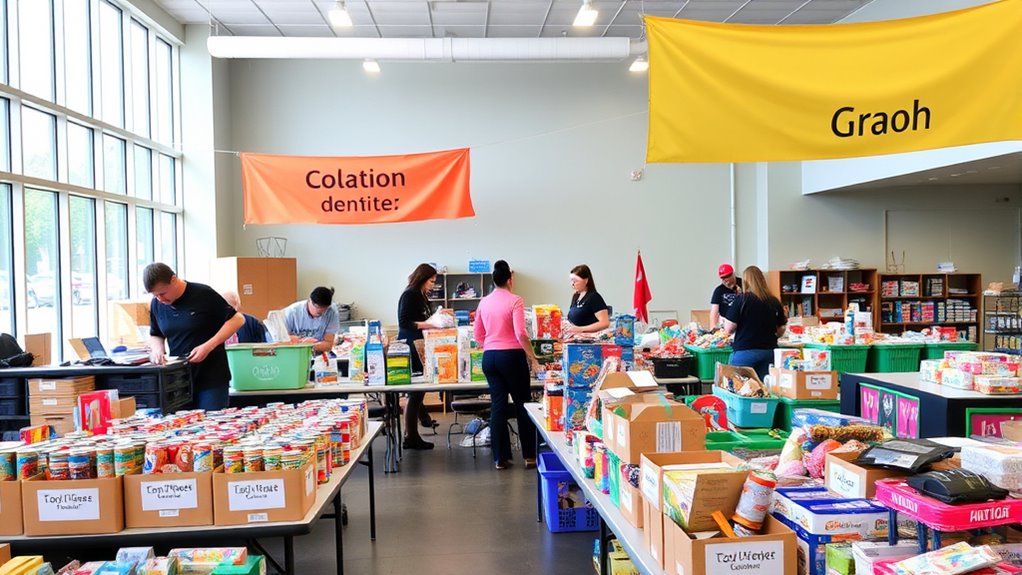
Selecting the types of donations and collection items is a crucial step in ensuring your drive meets its goals. You need to carefully consider material selection to match your community’s needs and your organization’s capacity. Start by defining clear donation categories, such as clothing, non-perishable food, or school supplies. Choosing specific items helps guide donors and streamlines collection efforts. Focus on materials that are easy to store, transport, and distribute, avoiding items that may spoil or become obsolete. Communicating your preferred donation categories clearly through your outreach channels not only encourages targeted contributions but also minimizes unwanted items. Ensuring proper storage and handling of donations, such as shelf life considerations, is essential for maintaining their quality and usability. Implementing storage best practices can further optimize your collection process and reduce waste. Incorporating risk mitigation strategies can further safeguard your collection process against unforeseen issues. By thoughtfully selecting donation types, you’ll make your drive more efficient and impactful, ultimately helping you reach your mission effectively.
Select a Suitable Location and Collection Site
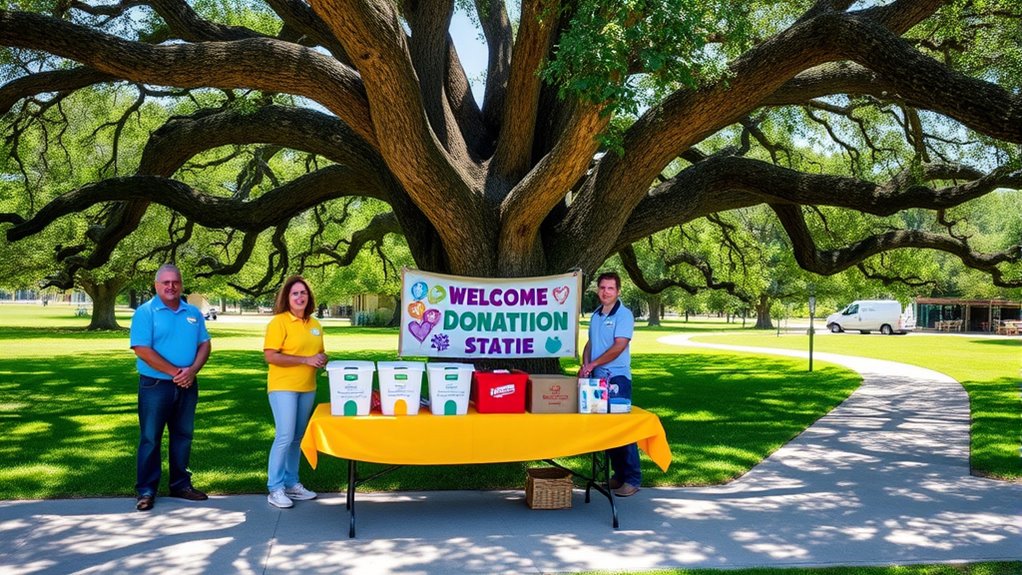
Choosing the right location for your collection site is essential to guarantee easy access and maximize participation. You should consider a public space, like a community center or park, where foot traffic is high and visibility is guaranteed. These areas attract more donors and make drop-offs convenient. Alternatively, a private venue such as a school, church, or office building can provide a controlled environment, ensuring safety and privacy for donors. When selecting a location, check for accessibility, parking options, and any permits needed. Make sure the space is large enough to accommodate collection bins and staff. A well-chosen site increases the likelihood of success and encourages community involvement. Always aim for a visible, easily reachable location to boost donations. Additionally, understanding family photoshoot fails can help you create a welcoming environment that captures positive community spirit, especially when considering the importance of a community space that fosters trust and engagement. Ensuring the location aligns with public safety standards will also promote a smooth and secure donation process for everyone involved. Incorporating knowledge about business diversification strategies, like offering multiple collection points, can further enhance the effectiveness of your drive.
Plan Your Timeline and Set a Schedule

Creating a clear timeline and schedule is essential to keep your donation drive organized and on track. You’ll want to set specific dates for key activities, such as volunteer recruitment, promotion, and collection days. This helps guarantee everyone knows their responsibilities and deadlines. When planning, consider your budget to allocate funds wisely for marketing, supplies, and volunteer needs. Recognizing potential challenges, such as managing manipulative behaviors, can help you develop contingency plans for smoother operations. Additionally, understanding the importance of well-being tips can support the mental resilience of your team during the busy planning process. Incorporating sound healing science principles, like scheduled breaks with calming music, can help reduce stress among volunteers. Furthermore, paying attention to essential oil benefits may foster a more relaxed and positive environment during planning and execution. Key steps include: – Establish deadlines for recruiting volunteers and confirming their roles – Schedule promotional events to maximize outreach before the drive – Set a timeline for collecting, sorting, and distributing donations A well-structured schedule keeps your team focused, prevents last-minute chaos, and ensures your donation drive runs smoothly from start to finish.
Gather Supplies and Prepare Collection Containers
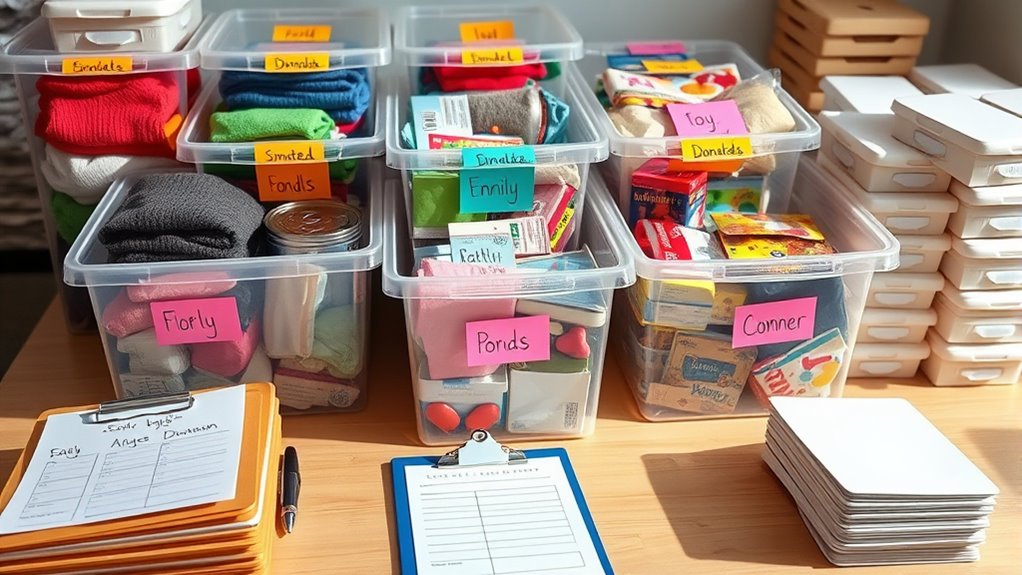
Before you begin collecting donations, it’s important to gather all the necessary supplies and prepare your collection containers. Ensure you have sturdy bins, boxes, or containers labeled clearly for different items. If you’re supporting recycling initiatives, consider using recyclable bins. Reach out to local businesses or organizations for corporate sponsorships that can provide supplies or containers. Use the table below to organize your collection plan:
| Item Needed | Purpose | Notes |
|---|---|---|
| Recyclable bins | Collect recyclable items | Supported by recycling initiatives |
| Donation boxes | Collect clothing, toys | Label for clarity |
| Labels | Identify different items | Use waterproof labels |
| Pens | Labeling containers | For writing on labels |
| Signage | Guide donors | Clear instructions |
Proper preparation makes collection easier and boosts your drive’s success. Additionally, ensuring the security of donations through proper handling and storage can prevent theft or loss during the drive. Conducting a security assessment before the event can help identify potential vulnerabilities. Implementing effective security measures can further safeguard the donations and maintain donor trust. A well-organized collection process can also help mitigate security vulnerabilities associated with handling donations.
Promote Your Donation Drive Effectively
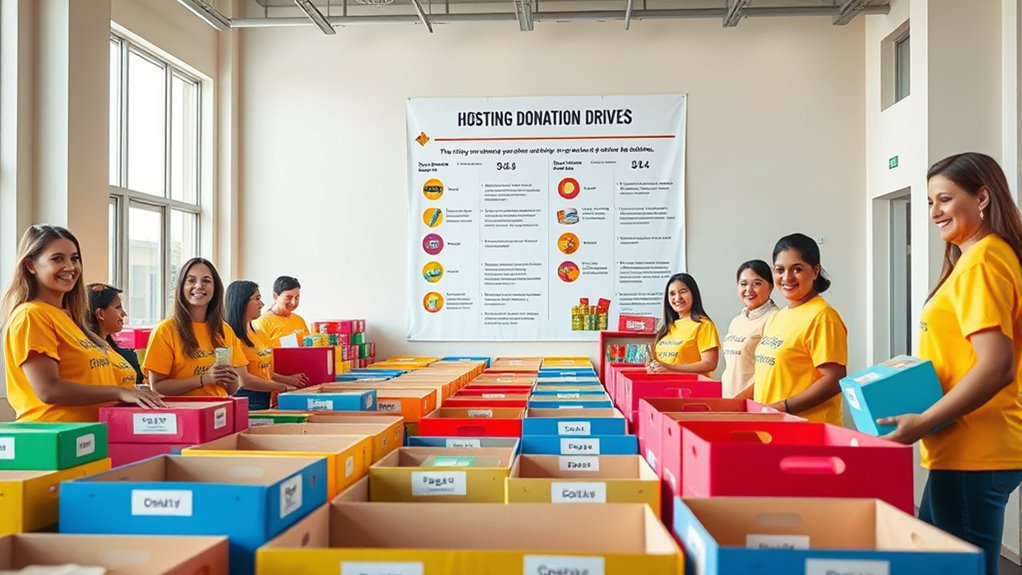
To get your donation drive noticed, leverage social media platforms to reach a wider audience quickly. Engage local communities through flyers, word-of-mouth, and partnerships to build support. By combining online and offline efforts, you’ll maximize awareness and boost donations effectively. Additionally, researching target demographics can help tailor your messaging to resonate more effectively with potential donors. Incorporating advanced segmentation techniques can further refine your outreach, ensuring your message reaches the most interested audiences.
Utilize Social Media Platforms
Social media platforms are powerful tools to spread the word about your donation drive quickly and reach a broad audience. To maximize your impact, develop effective social media strategies that encourage sharing and engagement. Focus on creating viral content by crafting compelling stories, eye-catching visuals, and clear calls-to-action. Use hashtags relevant to your cause to increase visibility and connect with like-minded communities. Encourage supporters to share your posts to amplify your reach organically. Regular updates and behind-the-scenes glimpses keep followers engaged and motivated to participate. Remember, the key is consistency and authenticity—people are more likely to support your cause when they see genuine passion and impactful content. With the right approach, your donation drive can gain momentum and inspire widespread participation.
Engage Local Communities
How can you guarantee your donation drive resonates locally? The key is engaging your community through meaningful partnerships. Reach out to local organizations, schools, and faith groups to build community partnerships that foster trust and support. Be mindful of cultural sensitivities; tailor your messaging and materials to respect diverse backgrounds. Host events or info sessions within the community to encourage participation and show your genuine commitment. Use local media outlets and community bulletin boards to spread the word effectively. When you involve community members directly, they feel valued and are more likely to contribute. By respecting cultural nuances and collaborating with trusted local groups, your promotion becomes authentic and impactful, ensuring your donation drive gains the visibility and support it needs.
Engage Volunteers and Assign Roles
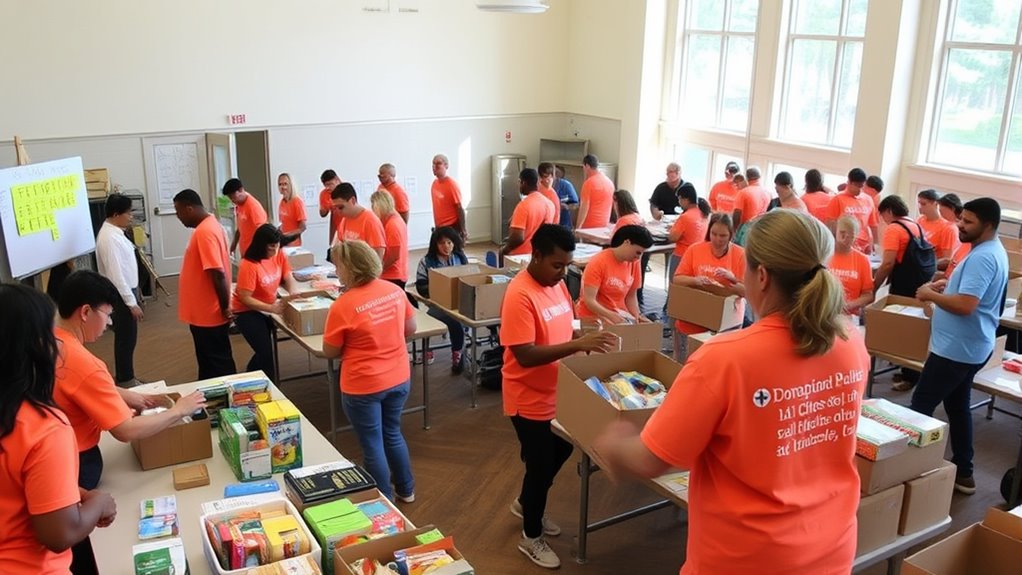
Engaging volunteers and assigning roles early on are crucial steps to guarantee your donation drive runs smoothly. Effective volunteer recruitment ensures you have enough help, while clear role assignment keeps everyone organized. When recruiting, focus on individuals with enthusiasm and reliability. Once recruited, assign roles based on skills and interests to maximize efficiency. Consider creating specific positions like registration helpers, collection coordinators, and outreach assistants. Communicate each role’s responsibilities clearly to avoid confusion. This proactive approach streamlines operations and motivates your team. Remember, well-defined roles prevent overlaps and ensure all aspects of the drive are covered. Engaged volunteers feel valued and contribute more effectively, making your donation drive a success from start to finish.
Set Up the Collection Site and Manage Donations
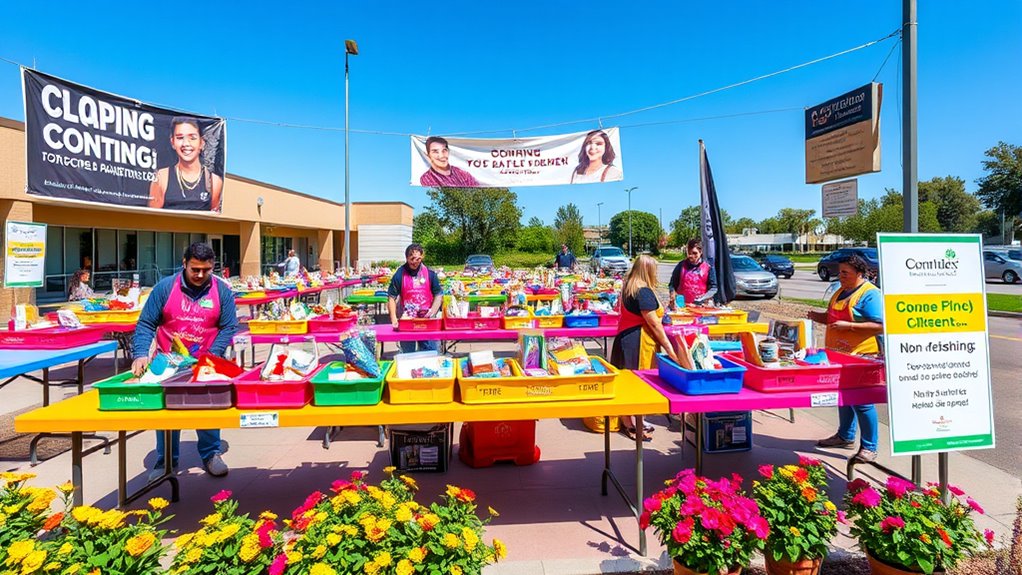
Setting up the collection site effectively is essential for smooth donation management. Choose a accessible, organized space where volunteers can easily coordinate. Clearly label donation bins and create designated areas for different items to streamline donation tracking. Guarantee volunteers are trained in managing the site, guiding donors, and recording donations accurately. Use simple forms or digital tools to track each donation’s details, preventing loss or confusion. Keep the area tidy and well-staffed to avoid bottlenecks. Regularly communicate with volunteers to address issues promptly. By maintaining a well-organized collection site and active volunteer coordination, you’ll ensure donations are collected efficiently and recorded accurately, setting a solid foundation for a successful drive.
Thank Donors and Acknowledge Supporters
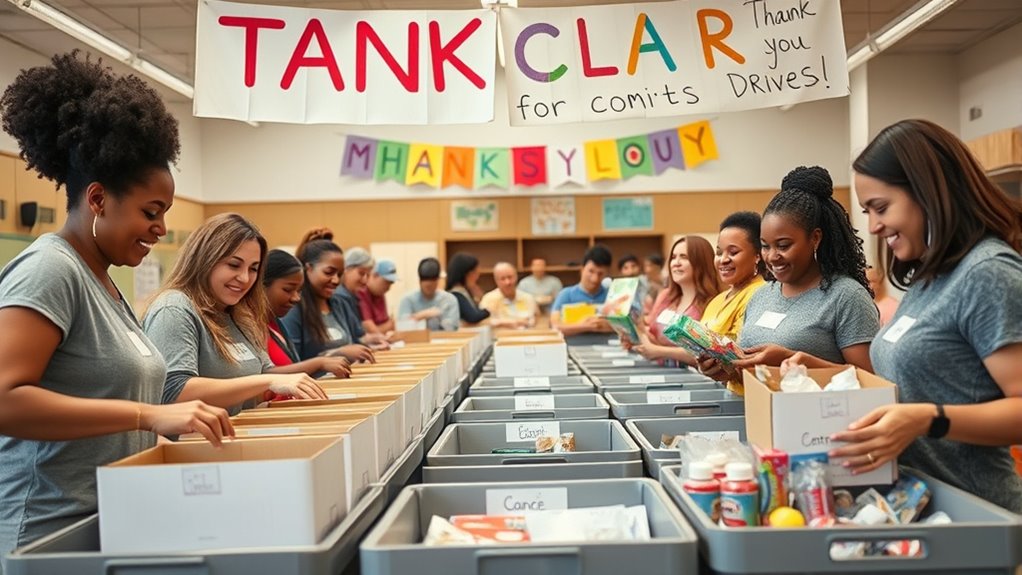
Thank your donors personally and make them feel appreciated. Highlight how their support made a difference to inspire continued involvement. Use various channels like social media, emails, or handwritten notes to reach everyone effectively.
Personalize Your Thanks
Once you’ve gathered your donations, taking the time to personalize your thanks can make a meaningful impact. Personalized gratitude shows donors their support is truly valued and encourages future involvement. To effectively recognize donors, consider handwritten notes, personalized emails, or phone calls that reflect their specific contribution. These gestures reinforce donor recognition and build stronger relationships. You can also include details about how their donation will be used, demonstrating transparency and appreciation. Remember, genuine acknowledgment makes donors feel appreciated and motivated to continue supporting your cause. Simple acts of gratitude can transform a one-time gift into a lasting partnership. Your personalized approach is key to fostering trust and loyalty within your supporter community.
Highlight Donor Impact
Recognizing your donors’ support by highlighting their impact can considerably strengthen their connection to your cause. Sharing donor stories showcases real-life examples of how their contributions make a difference. These stories personalize the impact measurement, turning abstract data into relatable, inspiring narratives. When you thank donors publicly or privately, emphasize the tangible outcomes their support has achieved. This acknowledgment not only boosts donor morale but also encourages ongoing engagement and generosity. By clearly illustrating the effect of their donations, you foster a sense of ownership and pride. Remember, donors want to see that their support is meaningful and effective. Highlighting impact isn’t just about gratitude; it’s about building lasting relationships rooted in transparency and shared success.
Use Multiple Channels
Using multiple channels to thank donors and acknowledge supporters guarantees your appreciation reaches everyone effectively. By diversifying your communication, you enhance creative fundraising efforts and boost donor recognition. This approach assures no supporter feels overlooked and helps build stronger relationships. Consider these methods:
- Send personalized thank-you emails or handwritten notes to add a heartfelt touch.
- Share public acknowledgments on social media to celebrate contributors and inspire others.
- Host appreciation events or virtual gatherings where supporters can be recognized directly.
These channels allow you to express gratitude in meaningful ways, reinforcing the importance of each contribution. Combining traditional and digital methods creates a thorough recognition strategy that resonates with supporters and encourages ongoing involvement.
Distribute Collected Items and Follow Up
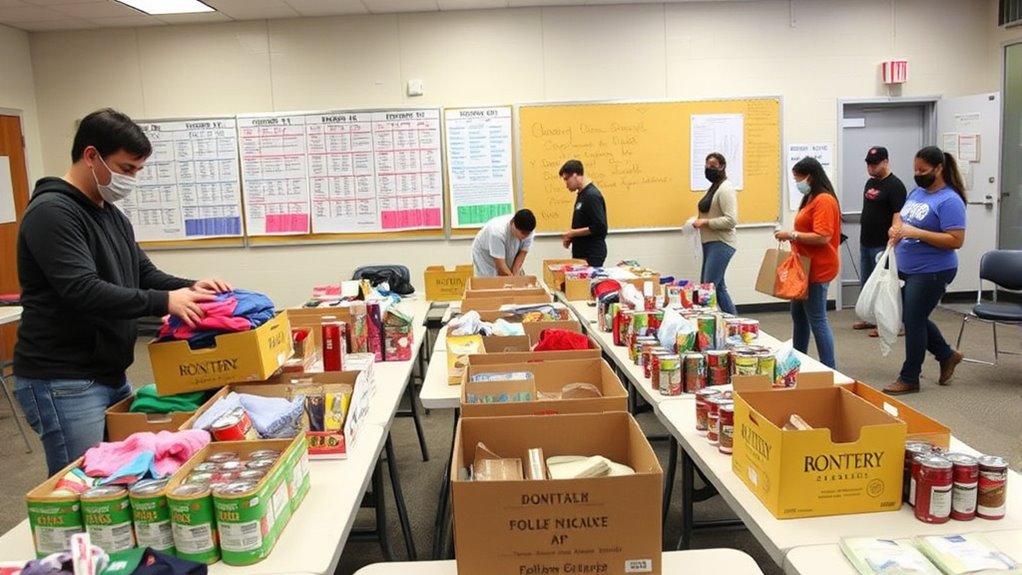
After collecting the donated items, it’s important to organize and distribute them efficiently to guarantee they reach those in need. Start by coordinating volunteers to assist with donation sorting, ensuring items are categorized and checked for quality. Clear communication helps volunteers understand their roles during distribution. Once sorted, plan how to deliver donations, whether through partnerships with local organizations or direct distribution events. After distribution, follow up with recipients and partners to confirm items reached those in need and gather feedback. This not only ensures accountability but also builds trust. Keep detailed records of what was distributed and to whom. Effective volunteer coordination and donation sorting streamline the process, making sure your drive achieves its impact and fosters ongoing support.
Frequently Asked Questions
How Do I Handle Unexpected Challenges During the Drive?
When unexpected challenges arise during your drive, you should rely on contingency planning and volunteer coordination. Quickly assess the issue, communicate clearly with your team, and adapt your plans as needed. Having backup options and designated roles helps manage surprises efficiently. Your proactive approach ensures the drive continues smoothly, keeping everyone focused and motivated. Stay flexible, involve your volunteers, and trust your preparation to navigate any unforeseen obstacles effectively.
What Legal Considerations Should I Be Aware Of?
When hosting a donation drive, you need to guarantee legal compliance by understanding local laws and regulations. Be aware of tax implications for donors and your organization, such as providing receipts for tax deductions. Keep accurate records of donations and expenses, and consider consulting a legal expert to avoid issues. Staying informed about legal considerations helps protect your organization and builds trust with donors, making your drive more successful.
How Can I Ensure Donations Are Distributed Ethically?
Think of your donation drive like a well-tended garden; ethical distribution and transparency practices guarantee every plant gets its fair share. To do this, set clear guidelines on how donations are allocated, communicate openly with donors and recipients, and track distribution carefully. Regularly update stakeholders on progress, and address concerns promptly. This approach builds trust and secures donations serve their intended purpose ethically and effectively.
How Do I Evaluate the Success of My Donation Drive?
You evaluate your donation drive’s success by tracking volunteer recruitment and social media outreach efforts. Look at how many volunteers signed up and how far your message spread online. Measure the total donations collected and compare it to your goals. Gather feedback from volunteers and recipients to understand the impact. This helps you see if your outreach and recruitment strategies effectively met your drive’s objectives and community needs.
What Are Common Mistakes to Avoid in Hosting a Drive?
When hosting a drive, avoid common mistakes like neglecting volunteer recruitment and poor publicity strategies. You might struggle with low participation if you don’t actively recruit volunteers or overlook effective publicity. Guarantee you plan outreach early, use social media, and clearly communicate goals. Also, don’t underestimate the importance of organizing logistics and setting realistic expectations. By avoiding these pitfalls, you increase your drive’s chances of success and maximize your impact.
Conclusion
Hosting a successful donation drive makes a real difference—did you know that community efforts can increase donations by up to 40% when properly organized? By following these steps, you’ll maximize your impact and inspire others to join your cause. Remember, clear goals and heartfelt appreciation turn donors into lifelong supporters. Keep your focus, stay organized, and watch your drive create meaningful change in your community.









